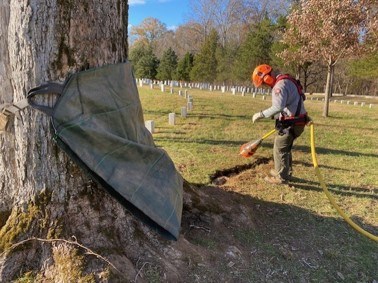Last updated: November 8, 2024
Article
Relieving Compaction around Tree Roots

NPS
The health and condition of a tree begins at the base. Repeated foot or equipment traffic can damage the health of a tree through wear and soil compaction. Soil compaction occurs when the pore space is reduced, limited the movement and availability of air and water. When this happens around roots at the base of a tree, it limits the fertility of roots and can be harmful to the entire tree. Dieback in the canopy of a tree can be an indication of compaction around the root zone.
The Air-Powered Excavation Spade
In several national cemeteries, NPS staff have used an air-powered excavation spade to relieve compaction around tree roots. This process loosens soil without damaging roots, which enables water and air to move more freely. The technique also makes it easier to blend amendments into the soil.
NPS

NPS
How Does it Work?
The hand-held air pressure tool is used for vertical trenching or radial mulching.
-
In radial trenching, the tool is used to excavate trenches in the critical root zone, below the tree canopy, extending outward from the trunk.
- In vertical mulching, the tool is used to create boreholes around the base of a tree.
The nozzle of the spade produces a laser-like jet of air, moving at 1,200 miles per hour. This nozzle is mounted to the end of a fiberglass barrel, which is attached to a control handle with a pressure gauge.
The tool is powered by a tow-behind compressor, connected to an air supply hose. For radial trenching, the operator holds the nozzle just above the soil at a 45 degree angle, using the air pressure to excavate 1 to 2 feet of surface per second. To dig boreholes, the operator plunges the nozzle into the soil with the trigger depressed.

NPS
The trench or holes are filled with a mixture of the excavated soil and compost or sand. Then, mulch is added to the surface around the base of the tree, adding nutrients and protecting against further compaction.

NPS
Additional Resources
Descriptive Transcript
The high pressure air from the tool makes a consistant whooshing sound as the operator directs it towards the soil.
- Duration:
- 1 minute, 9 seconds
A high pressure stream of air from the air-powered excavation spade is carefully directed around the base of a tree in the national cemetery at Little Bighorn Battlefield National Monument, forming trenches that extend outward from the trunk. This loosens the compacted soil around tree roots, improving the flow of air, water, and nutrients and improving the overall health of the tree. Note the protective equipment and the archeologist monitoring the process.
